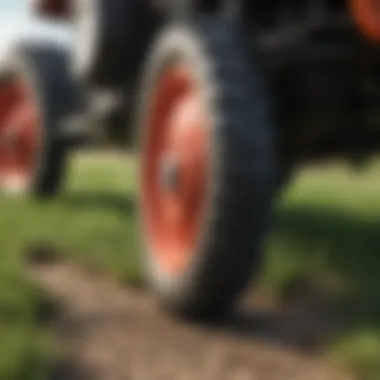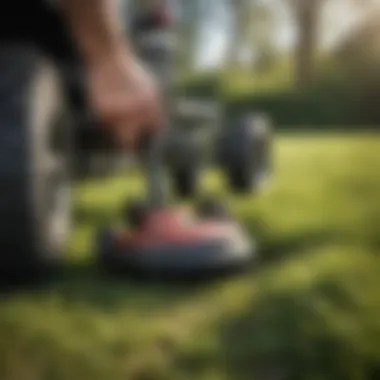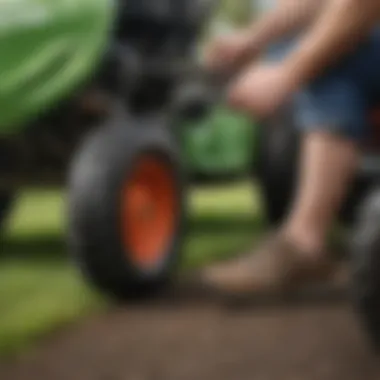Understanding Lawn Mower Foot Throttles


Intro
Lawn care is a critical aspect of maintaining residential and commercial properties. A vital component of efficient lawn mowing is the throttle system, particularly foot throttles. These devices allow operators to control the engine speed with their foot, promoting ease of use and improving maneuverability. As more people recognize the benefits of foot throttles, understanding their mechanisms, applications, and maintenance becomes crucial for both professional landscapers and gardening enthusiasts.
This article will explore the complexity and utility of foot throttles in lawn mowers, presenting a thorough examination of their functionality, advantages, and maintenance practices. By diving into where foot throttles are commonly found and how they add value, the aim is to enhance the readers' knowledge and encourage optimal performance in lawn maintenance pursuits.
Preamble to Lawn Mower Foot Throttles
Lawn mower foot throttles are a significant component in the operation of various mower types. Understanding their mechanisms is crucial for effective lawn maintenance. Foot throttles offer several practical advantages over traditional hand throttles, providing operators with a superior experience in various mowing conditions. They enhance control and reduce strain on the operator, especially during extended use. Consequently, learning about foot throttles ensures that users can make informed decisions when selecting their equipment.
Definition and Purpose
Foot throttles are designed as pedals that control the engine's speed and power output. By utilizing a foot throttle, operators can adjust the mower's speed effortlessly without taking their hands off the steering or control mechanisms. The primary purpose of these throttles is to allow for seamless speed adjustments, which is especially beneficial in uneven terrains or varied mowing patterns. This design feature makes foot throttles a preferred choice for many professionals and gardening enthusiasts alike.
Historical Context
The evolution of lawn mower foot throttles is linked to the broader developments in mower technology. Initially, lawn mowers utilized manual hand throttles, which required constant hand movement, often leading to operator fatigue. Over the years, engineers recognized the need for a more ergonomic solution. The introduction of foot throttles marked a turning point in lawn care technology. Early models appeared in the mid-20th century, and since then, they have become increasingly common in ride-on mowers and high-end walk-behind models. The adoption of these mechanisms reflects an ongoing commitment to improving user comfort while enhancing mowing efficiency.
"Foot throttles transformed the way we approach lawn maintenance, allowing for greater versatility and ease of use."
Mechanisms Behind Foot Throttles
Understanding the mechanisms behind foot throttles is essential for anyone who operates lawn mowers. This section will delve into how these devices function, their advantages, and their significance in modern lawn care. The design and operation of foot throttles highlight their user-friendliness and effectiveness compared to other throttle options.
Basic Operation Principles
Foot throttles operate on a straightforward principle. When the operator presses the foot pedal, it regulates the engine's power output. This modulation controls the speed of the mower. The construction typically involves a cable system that connects the pedal to the engine's throttle arm. When pressure is applied, the cable tension changes, leading to an increase or decrease in the engine's RPM (revolutions per minute).
The response of the throttle is critical. A well-calibrated foot throttle ensures immediate feedback, allowing operators to adjust speed seamlessly. This is particularly advantageous when navigating uneven terrain or maneuvering around obstacles, as it promotes natural movement and dynamic steering without constant hand adjustments.
In addition to basic operation, various components such as springs and levers contribute to the effective operation of a foot throttle. Springs facilitate the return of the pedal to its resting position when pressure is released, ensuring that the mower returns to idle without delay. Special attention to these mechanisms ensures longevity and reliability of the equipment.
Comparison with Hand Throttles
When comparing foot throttles to hand throttles, several factors come into play that highlight the advantages of foot-operated mechanisms. One significant aspect is comfort. Using foot throttles allows operators to maintain a more neutral posture. Unlike hand throttles, which can lead to wrist strain after prolonged use, foot throttles reduce physical tension, especially during extended mowing tasks.
Moreover, foot throttles offer enhanced control and precision. Operators can focus on steering and maneuvering without the strain of hand throttles. The foot pedal allows for smoother acceleration and deceleration, resulting in a cleaner cut and better overall lawn appearance.
Another key consideration is safety. In situations where quick adjustments are necessary, being able to control the mower with a foot throttle allows operators to keep their hands free. This is especially beneficial for those working in commercial settings where time and safety are both of utmost priority.
In summary, the mechanisms behind foot throttles illustrate their crucial role in improving operator comfort, control, and safety when mowing. Understanding these mechanisms is valuable for both new and experienced users, maximizing the efficiency of lawn maintenance activities.
Advantages of Using Foot Throttles
Foot throttles, as a feature in lawn mowers, offer several noteworthy advantages that enhance the overall mowing experience. These benefits are critical for both casual users and industry professionals who require efficiency and effectiveness in their lawn care tasks. Understanding these advantages can help users appreciate why many modern lawn mowers utilize foot throttles instead of traditional hand-operated options.
Increased Operator Comfort


One significant advantage of foot throttles is the comfort they provide to the operator. Instead of relying solely on hand control, foot throttles allow the operator to keep both hands free for steering and maneuvering. This is especially beneficial in ride-on mowers, where extended periods of use can lead to discomfort.
Ergonomics plays a crucial role here. Operators can adjust their foot position more naturally than they could their hands. Since the feet are more stable during operation, users experience less strain while mowing their lawns. This can be particularly advantageous for those suffering from conditions such as arthritis or repetitive strain injuries, which might make prolonged use of hand throttles cumbersome.
Enhanced Control and Precision
Another important aspect of foot throttles is the level of control and precision they offer. With a foot throttle, the operator can smoothly adjust the speed of the mower without having to take their hands off the steering mechanism. This seamless transition allows for more precise handling, which is vital when navigating around obstacles or changing terrains.
In challenging environments, such as gardens with uneven surfaces or obstacles, the ability to control speed with the feet gives the operator a distinct advantage. It allows users to focus on steering while making subtle speed adjustments as necessary. Consequently, this helps in achieving a cleaner cut without damaging the landscape, making foot throttles a wise choice for detailed lawn care tasks.
Reduced Fatigue in Extended Use
Using foot throttles also contributes to reduced fatigue during extended mowing sessions. Traditional hand throttles can lead to cramping or tiredness due to the constant grip required. With foot throttles, operators can shift their weight and relieve the tension in their hands and arms. This feature is particularly relevant for professionals who spend many hours operating mowing equipment.
Studies have shown that operators using foot throttles report feeling less exhausted after long periods of use. Being able to use larger muscles in the legs compared to the smaller muscles of the hands can enhance endurance. As a result, operators can maintain focus and efficiency, ultimately improving overall productivity in lawn maintenance tasks.
"Foot throttles significantly change the user experience, promoting comfort and reducing fatigue for those who operate lawn mowers frequently."
In summary, the advantages of using foot throttles are substantial. Increased comfort, better control, and reduced fatigue are just some of the factors that make these devices appealing. As technology evolves, foot throttles will likely become an even more common feature in lawn mower designs, improving the user's experience further.
Types of Lawn Mowers with Foot Throttles
Understanding the types of lawn mowers that incorporate foot throttles is crucial for grasping their applications and significance in lawn maintenance. The mechanism allows for varying speed and engine control while allowing the operator to focus on steering and navigation. This section examines three principal categories: ride-on lawn mowers, walk-behind models, and the distinction between commercial and residential usage.
Ride-On Lawn Mowers
Ride-on lawn mowers are designed for larger spaces. These models often feature a robust design, meant to provide comfort during extended periods of mowing. The foot throttle mechanism is an essential part of their operation, enabling users to adjust engine speed effectively without needing to take their hands off the steering controls.
The efficiency of ride-on mowers is evident in various scenarios, such as maintaining golf courses or large estates. Operators can experience less fatigue due to the ergonomic design and decreased need for constant manual adjustments. Additionally, with foot throttles, users appreciate smoother speed transitions while navigating uneven terrain or tight corners.
Walk-Behind Models
Walk-behind models are more compact, generally suited for smaller lawns. These mowers require the operator to walk behind the machine, using a foot throttle to manage speed. This design integrates agility with ease of use, offering a different experience compared to ride-on versions.
The application of foot throttles in walk-behind mowers allows for superior control over maneuverability. These machines still maintain a reliable rhythm and momentum through the user’s intricate control over speed. Larger walk-behind models, often referred to as commercial-grade, may emphasize durable construction and robust power, taking advantage of the foot throttle mechanism to handle tougher mowing conditions.
Commercial vs. Residential Usage
The differentiation between commercial and residential usage pertains to the scale and frequency of use. Commercial mowers equipped with foot throttles are built with durability and efficiency in mind. They can handle high workloads in a variety of conditions, making them a staple for landscaping companies.
In contrast, residential models cater to average homeowners. Their features may not be as robust as commercial mowers, but they still offer adequate performance for regular lawn care. Understanding the intended use significantly benefits buyers in making informed choices about what mower to purchase.
In summary, recognizing the types of lawn mowers equipped with foot throttles is vital for users seeking efficiency and convenience in their lawn care tasks. Each category serves unique needs, thus contributing to optimal functionality in their specific applications. Applying this knowledge leads to more informed decisions for both professional landscapers and everyday users.
Maintenance of Lawn Mower Foot Throttles
Maintaining lawn mower foot throttles is crucial for optimal performance and longevity of the equipment. Foot throttles play an important role in regulating the speed of the mower, affecting how effectively grass is cut and how the machine handles on different terrains. Regular maintenance can prevent malfunctions that may disrupt mowing efficiency. 📏
Proper upkeep ensures a smooth operation, reduces the risk of premature wear, and extends the overall lifespan of the mower. Furthermore, well-maintained throttles contribute to the comfort of the operator. They can help in avoiding unnecessary physical strain caused by malfunctioning equipment.


Regular Inspection Practices
Regular inspections are the foundation of effective maintenance. Here are some practices to consider:
- Visual Checks: Inspect the throttle for any visible signs of wear and tear, such as cracks or bendings.
- Functionality Tests: Test the foot throttle response to ensure it operates smoothly and without sticking.
- Component Checks: Ensure that all connecting cables and levers are intact and functioning as intended.
These practices enable early detection of potential problems before they escalate into serious issues, which could result in costly repairs.
Cleaning and Lubrication Techniques
Proper cleaning and lubrication are essential for maintaining optimal throttle functionality. Consider these steps:
- Clean the Throttle Housing: Remove any grass clippings, dirt, or debris that might affect performance. Use a mild detergent and a soft brush to clean.
- Lubricate Moving Parts: Apply a recommended lubricant to the pivot points and moving parts to reduce friction.
- Wipe Down Surfaces: After lubricating, wipe down the throttle surfaces to remove any excess oil that could attract more dirt.
Regular cleaning not only improves performance but also helps in preventing corrosion and other wear-related issues.
Common Wear and Tear Issues
Over time, several issues may arise that affect the foot throttle. Being aware of common problems can help in addressing them quickly:
- Sticking Throttle: This typically occurs due to debris build-up or inadequate lubrication.
- Delayed Response: A lack of maintenance can cause the throttle to respond slowly, making mowing inefficient.
- Cable Fraying or Breakage: Regular usage can lead to fraying of throttle cables, which may need replacement.
Identifying these issues swiftly can save time and money, ensuring that the mower continues to operate efficiently.
Troubleshooting Common Foot Throttle Issues
In the realm of lawn mower operation, feet throttles offer distinct advantages. However, users may sometimes face challenges. Understanding these issues is vital for maintaining efficiency in lawn care. This section addresses common problems associated with foot throttles, outlining effective troubleshooting methods and tips for optimal performance.
Throttle Sticking Problems
One prevalent issue encountered by operators is throttle sticking. This can manifest when the foot throttle does not return to its idle position after being pressed. Such problems can be caused by dirt, debris, or a lack of lubrication within the throttle mechanism.
- Symptoms: If you notice that the mower's engine remains revved up even after releasing the throttle, it is a clear sign of this issue. Sticking can also lead to decreased control while mowing.
- Causes: Common causes include accumulated grass clippings around the throttle components or corrosion that might occur from exposure to moisture.
To address throttle sticking problems, follow these steps:
- Clean the throttle area, removing any grass or dirt that may be obstructing movement.
- Inspect the throttle cable for any signs of wear or damage.
- Apply an appropriate lubricant to the throttle spring and linkage to ensure smooth operation.
Timely intervention can save time and enhance the lifespan of your lawn mower foot throttle. Regular inspection is key to preventing sticking issues.
Response Delay and Sensitivity Adjustments
Another common issue is the detection of response delay when using the foot throttle. This can happen when there is a noticeable lag between pressing the throttle and the mower's acceleration. Such delays can impact efficiency, especially in tasks requiring precision.
- Symptoms: A response delay can be felt during acceleration, leading to an awkward operation where the mower does not react promptly to the operator's commands.
- Causes: This issue may stem from improper adjustments in the throttle linkage or could be due to wear in the components that connect the throttle pedal to the engine.
To troubleshoot response delay, consider the following actions:
- Check the throttle linkages for any disconnections or misalignment that could lead to delay.
- Adjust the sensitivity settings if the mower is equipped with such features. Ensuring that these settings are appropriate can enhance responsiveness.
- Consult the mower’s manual for guidance on adjusting throttle settings and maintaining optimal performance.


Regular maintenance and proper adjustments can significantly improve the throttle's responsiveness and eliminate lag, ensuring a smoother mowing experience.
Both throttle sticking and response delay are issues that can hinder the performance of foot throttles in lawn mowers. Understanding these problems and their solutions allows operators to maintain efficiency and effectiveness while taking care of their lawn.
Foot Throttle Innovations and Technology
The landscape of lawn care technology is evolving rapidly. Innovations in foot throttles play a pivotal role in this transformation, enhancing operator experience and mower functionality. Understanding these innovations is crucial for both manufacturers and users to optimize performance, safety, and efficiency in lawn maintenance tasks.
Emerging Features in Modern Mowers
Modern lawn mowers are increasingly integrated with sophisticated features in their foot throttle systems. One noticeable trend is the introduction of adjustable throttle control, allowing operators to fine-tune the engine's speed based on the terrain and grass conditions. This flexibility greatly enhances maneuverability, particularly in uneven or complex landscapes.
Another innovation is the development of responsive throttle response systems. These systems allow for quick adjustments to power output with minimal foot pressure. This improvement results in smoother operation and reduced operator fatigue, especially during extended mowing sessions. Additionally, advancements in materials used for foot throttles contribute to durability and resistance to wear and tear, ensuring that these parts withstand the rigors of regular use.
Integration with Smart Technology
The integration of smart technology into lawn mowers is becoming more prevalent. Foot throttles are no exception. Some modern mowers now feature connectivity options that allow them to communicate with mobile applications. This integration enables users to monitor the mower's performance and adjust settings remotely, providing a more customized mowing experience.
"Smart technology can transform how we approach lawn care, making it more intuitive and efficient."
Moreover, smart foot throttles can adapt to different mowing scenarios based on previously collected data. For example, they may adjust power levels automatically when tackling hilly terrains or varying grass densities. This adaptive performance is particularly beneficial for professional landscapers who require precise control over their equipment under differing conditions.
User Experiences and Feedback
User experiences and feedback provide invaluable insights into the real-world applications of foot throttles in lawn mowers. They help potential buyers understand how these mechanisms perform under various conditions. Real accounts from users contribute to a holistic view of both the strengths and weaknesses of these systems. This information is essential for making informed decisions and improving product designs.
Case Studies of Lawn Care Professionals
Lawn care professionals rely heavily on their equipment for efficiency and effectiveness. Foot throttles play a significant role in enhancing the operation of their machines. For instance, many professionals report that ride-on mowers with foot throttles enable easier maneuverability and allow them to navigate tight spaces without sacrificing speed.
One notable case is a landscaping company in Florida that transitioned from hand-throttle mowers to models equipped with foot throttles. This change resulted in a 20% increase in productivity during peak seasons. The operators reported experiencing less strain on their hands and wrists. Additionally, being able to control the throttle with their feet allowed them to focus more on other tasks like steering and adjusting cutting height. This case highlights the practical benefits seen directly from the user perspective.
Consumer Reviews: Satisfaction and Preferences
Consumer reviews reflect a range of opinions about foot throttles in lawn mowers. While many users appreciate the convenience and efficiency, some express concerns regarding responsiveness and comfort. Reviews often point out features that consumers value. For example, ease of use is a common theme. Users preferred mowers with intuitive pedal layouts, stating that such designs simplified operation, especially during prolonged sessions.
Another consideration is preference for brands. Certain brands like John Deere and Cub Cadet consistently receive positive feedback for their sturdy and reliable foot throttle designs. Users note these brands often equip their machines with responsive throttles that require minimal effort, thereby reducing fatigue during extensive use.
"A good foot throttle should enhance the mowing experience, not complicate it. Comfort and responsiveness make all the difference during long hours of mowing."
Ending: The Role of Foot Throttles in Lawn Care
The topic of foot throttles holds significant importance in the landscape of lawn care. Understanding how these mechanisms enhance mower functionality leads to better user experience and improved lawn maintenance performance. Foot throttles allow operators to maintain optimal control over the mower speed while focusing on the task at hand. This feature is especially critical for professionals who require precision while navigating various terrains and conditions.
In summary, foot throttles not only offer increased comfort but also improve operator efficiency. The convenience of a foot-operated mechanism reduces the need for constant hand adjustments, allowing for more seamless mowing. Additionally, they promote safer operation by enabling the user to keep both hands on the steering controls.
The reliability of foot throttles can significantly influence the overall maintenance routine. When well-maintained, these systems can lead to consistent performance and longevity of the mower. Emerging technologies continue to push the boundaries of what foot throttles can achieve, promising exciting advancements in the future.
Summary of Key Points
- Functionality: Foot throttles provide increased control over mower speed, enhancing the overall mowing experience.
- Operator Comfort: They reduce fatigue during extended use, making the mowing process more manageable.
- Safety: Keeping hands on steering improves safety, reducing distractions while operating.
- Maintenance: Proper upkeep is crucial for ensuring the reliability and longevity of foot throttle systems.
Future Directions for Lawn Mower Design
The future of lawn mower design is likely to see significant integration of advanced foot throttle technologies. Innovations could include adaptive throttle response systems that adjust speed based on the terrain or user pressure sensitivity. Furthermore, incorporating smart technology might allow for real-time monitoring of performance metrics, providing users valuable feedback on mowing efficiency and potential maintenance needs. These advancements could revolutionize the lawn care industry, providing not only better user-friendliness but also enhanced overall effectiveness in lawn maintenance tasks.















